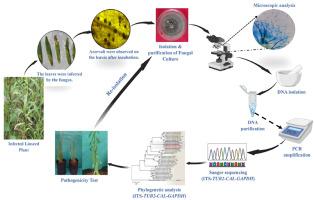Morpho-cultural and molecular characterization based on multigene phylogeny of Colletotrichum truncatum associated with leaf blight of linseed (Linum usitatissimum L.)
IF 3.3
3区 农林科学
Q2 PLANT SCIENCES
引用次数: 0
Abstract
Linseed, is an vital oilseed and imperative medicinal crop growing during the rabi season in the northern and mid regions of India, along with the northeastern districts of Karnataka. During the recent field surveys conducted in the 2023–24 and 2024–25 rabi seasons, characteristic leaf blight symptoms were observed with a severity ranging from 9.23 % to 23.33 %. Symptomatic leaf samples were collected and the pathogen was isolated on PDA. The colony initially appeared greyish white and later turned dark gray. The spores were generally falcate, unicellular, and hyaline. The identity of the pathogen as Colletotrichum truncatum was recognized based on the morpho-cultural observations. Further, identification was confirmed by molecular identification which was performed by amplifying and sequencing the ITS-rDNA region, along with TUB2, CAL, and GAPDH genes, using specific primers targeting the gDNA of two fungal isolates. The BLASTn analysis showed that the sequences of the ITS region, along with TUB2, CAL, and GAPDH, exhibited significant similarity with the reference sequences of C. truncatum. The multigene phylogenetic analysis performed, using the ITS-TUB2-CAL-GAPDH sequence alignment, revealed that the sequences obtained in the present study were closely aligned with respective reference sequences, thus, confirming the identity phylogenetically. Further pathogenicity tests were performed by applying the conidial suspension of C. truncatum onto the leaves of a 45-day-old linseed plant. Characteristic leaf blight symptoms developed within 8–10 days of post-inoculation, and the same pathogen was subsequently re-isolated and identified microscopically. To the best of our knowledge, this is the first report of Colletotrichum truncatum associated with leaf blight of linseed from India.

基于亚麻叶枯病相关炭疽菌多基因系统发育的形态培养及分子特征分析
亚麻籽是一种重要的油籽和药用作物,在印度北部和中部地区以及卡纳塔克邦东北部地区的rabi季节种植。在最近的2023-24和2024-25季进行的实地调查中,观察到典型的叶枯病症状,严重程度在9.23%至23.33%之间。采集有症状的叶片样品,在PDA上分离病原菌。蜂群最初呈灰白色,后来变成深灰色。孢子一般为镰形、单细胞和透明的。根据形态培养观察,确认病原菌为炭疽菌。此外,利用针对两株真菌分离株gDNA的特异性引物,对ITS-rDNA区域以及TUB2、CAL和GAPDH基因进行扩增和测序,从而进行分子鉴定。BLASTn分析显示,ITS区序列以及TUB2、CAL和GAPDH与C. truncatum的参考序列具有显著的相似性。使用ITS-TUB2-CAL-GAPDH序列比对进行多基因系统发育分析,发现本研究获得的序列与各自的参考序列非常接近,从而证实了系统发育上的一致性。进一步的致病性试验是通过在45 d龄的亚麻籽植物叶片上施用长角锥虫孢子悬浮液进行的。接种后8-10天内出现典型的叶枯病症状,随后再次分离并在显微镜下鉴定了同一病原体。据我们所知,这是首次报道与印度亚麻籽叶枯病相关的炭疽菌。
本文章由计算机程序翻译,如有差异,请以英文原文为准。
求助全文
约1分钟内获得全文
求助全文
来源期刊
CiteScore
4.30
自引率
7.40%
发文量
130
审稿时长
38 days
期刊介绍:
Physiological and Molecular Plant Pathology provides an International forum for original research papers, reviews, and commentaries on all aspects of the molecular biology, biochemistry, physiology, histology and cytology, genetics and evolution of plant-microbe interactions.
Papers on all kinds of infective pathogen, including viruses, prokaryotes, fungi, and nematodes, as well as mutualistic organisms such as Rhizobium and mycorrhyzal fungi, are acceptable as long as they have a bearing on the interaction between pathogen and plant.

 求助内容:
求助内容: 应助结果提醒方式:
应助结果提醒方式:


